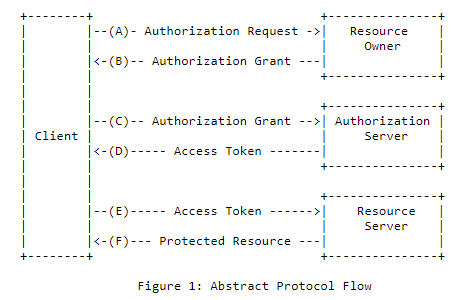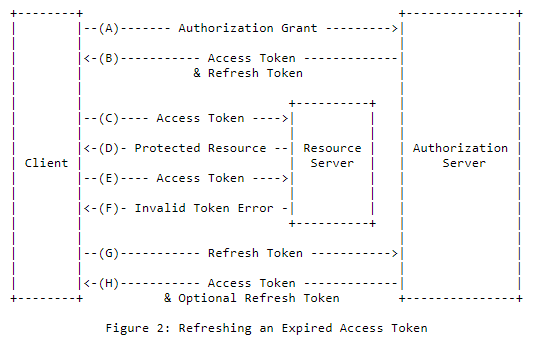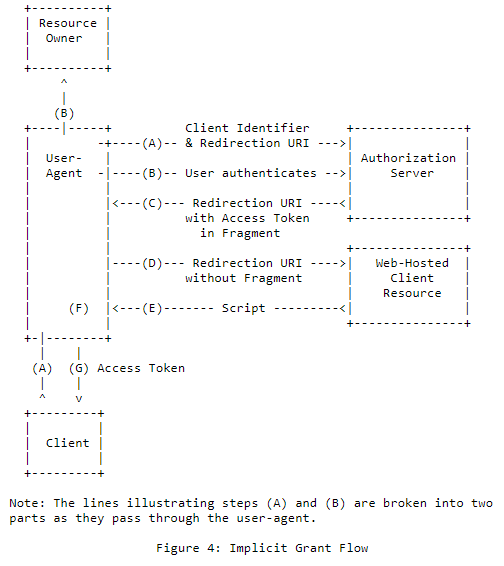What is OAuth 2.0
The OAuth 2.0 authorization framework enables a third-party application to obtain limited access to an HTTP service, either on behalf of a resource owner by orchestrating an approval interaction between the resource owner and the HTTP service, or by allowing the third-party application to obtain access on its own behalf.
Roles
OAuth defines four roles:
resource owner An entity capable of granting access to a protected resource.
When the resource owner is a person, it is referred to as an
end-user.
resource server
The server hosting the protected resources, capable of accepting
and responding to protected resource requests using access tokens.
client
An application making protected resource requests on behalf of the
resource owner and with its authorization. The term “client” does
not imply any particular implementation characteristics (e.g.,
whether the application executes on a server, a desktop, or other
devices).
authorization server
The server issuing access tokens to the client after successfully
authenticating the resource owner and obtaining authorization.
The interaction between the authorization server and resource server is beyond the scope of this specification. The authorization server may be the same server as the resource server or a separate entity. A single authorization server may issue access tokens accepted by multiple resource servers.
Work flow
THis work flow is a snapshot of RFC6749.

</p>
(A) The client requests authorization from the resource owner. The
authorization request can be made directly to the resource owner
(as shown), or preferably indirectly via the authorization
server as an intermediary.
(B) The client receives an authorization grant, which is a
credential representing the resource owner's authorization,
expressed using one of four grant types defined in this
specification or using an extension grant type. The
authorization grant type depends on the method used by the
client to request authorization and the types supported by the
authorization server.
(C) The client requests an access token by authenticating with the
authorization server and presenting the authorization grant.
(D) The authorization server authenticates the client and validates
the authorization grant, and if valid, issues an access token.
(E) The client requests the protected resource from the resource
server and authenticates by presenting the access token.
(F) The resource server validates the access token, and if valid,
serves the request.
</p>
Authorization Grant
An authorization grant is a credential representing the resource owner’s authorization (to access its protected resources) used by the client to obtain an access token. This specification defines four grant types:
authorization code The authorization code is obtained by using an authorization server
as an intermediary between the client and resource owner. Instead of
requesting authorization directly from the resource owner, the client
directs the resource owner to an authorization server (via its
user-agent as defined in [RFC2616]), which in turn directs the
resource owner back to the client with the authorization code.
Before directing the resource owner back to the client with the
authorization code, the authorization server authenticates the
resource owner and obtains authorization. Because the resource owner
only authenticates with the authorization server, the resource
owner’s credentials are never shared with the client.
implicit
The implicit grant is a simplified authorization code flow optimized
for clients implemented in a browser using a scripting language such
as JavaScript. In the implicit flow, instead of issuing the client
an authorization code, the client is issued an access token directly.
resource owner password credentials
The resource owner password credentials (i.e., username and password)
can be used directly as an authorization grant to obtain an access
token. The credentials should only be used when there is a high
degree of trust between the resource owner and the client.
client credentials
Client credentials are used as an authorization grant
typically when the client is acting on its own behalf (the client is
also the resource owner) or is requesting access to protected
resources based on an authorization previously arranged with the
authorization server.
Refresh Token
Refresh tokens are credentials used to obtain access tokens. Refresh tokens are issued to the client by the authorization server and are used to obtain a new access token when the current access token becomes invalid or expires, or to obtain additional access tokens with identical or narrower scope.

Client Registration
Before initiating the protocol, the client registers with the authorization server. The means through which the client registers with the authorization server are beyond the scope of this specification but typically involve end-user interaction with an HTML registration form.
Client Types
OAuth defines two client types, based on their ability to authenticate securely with the authorization server (i.e., ability to maintain the confidentiality of their client credentials):
- confidential
Clients capable of maintaining the confidentiality of their credentials
– public
Clients incapable of maintaining the confidentiality of their credentials
Client Identifier
The authorization server issues the registered client a client identifier — a unique string representing the registration information provided by the client.
Client Authentication
If the client type is confidential, the client and authorization server establish a client authentication method suitable for the security requirements of the authorization server.
Confidential clients are typically issued (or establish) a set of client credentials used for authenticating with the authorization server (e.g., password, public/private key pair).
- client_id
REQUIRED. The client identifier issued to the client during
the registration process described above.
– client_secret
REQUIRED. The client secret. The client MAY omit the
parameter if the client secret is an empty string.
Attention: The authorization server MUST require the use of TLS when sending requests using password authentication.
Authorization Code Grant

Authorization Request
- response_type
REQUIRED. Value MUST be set to “code”.
- client_id
REQUIRED. The client identifier
- redirect_uri
OPTIONAL. The Redirect URI
- scope
OPTIONAL. The scope of the access request
- state
RECOMMENDED. An opaque value used by the client to maintain
state between the request and callback. The authorization
server includes this value when redirecting the user-agent back
to the client. The parameter SHOULD be used for preventing
cross-site request forgery.
Authorization Response
- code
REQUIRED. The authorization code generated by the
authorization server. The authorization code MUST expire
shortly after it is issued to mitigate the risk of leaks. A
maximum authorization code lifetime of 10 minutes is
RECOMMENDED. The client MUST NOT use the authorization code more than once. If an authorization code is used more than
once, the authorization server MUST deny the request and SHOULD
revoke (when possible) all tokens previously issued based on
that authorization code. The authorization code is bound to
the client identifier and redirection URI.
- state
REQUIRED if the “state” parameter was present in the client
authorization request. The exact value received from the
client.
For example, the request
GET /authorize?response_type=code&client_id=s6BhdRkqt3&state=xyz
&redirect_uri=https%3A%2F%2Fclient%2Eexample%2Ecom%2Fcb HTTP/1.1
Host: server.example.com
the reponse
HTTP/1.1 302 Found
Location: https://client.example.com/cb?code=SplxlOBeZQQYbYS6WxSbIA
&state=xyz
Access Token Request
- grant_type
REQUIRED. Value MUST be set to “authorization_code”.
- code
REQUIRED. The authorization code received from the
authorization server.
- redirect_uri
REQUIRED, if the “redirect_uri” parameter was included in the
authorization request , and their values MUST be identical.
- client_id
REQUIRED, if the client is not authenticating with the
authorization server
For example,
the request
POST /token HTTP/1.1
Host: server.example.com
Authorization: Basic czZCaGRSa3F0MzpnWDFmQmF0M2JW
Content-Type: application/x-www-form-urlencoded
grant_type=authorization_code&code=SplxlOBeZQQYbYS6WxSbIA
&redirect_uri=https%3A%2F%2Fclient%2Eexample%2Ecom%2Fcb
the response
HTTP/1.1 200 OK
Content-Type: application/json;charset=UTF-8
Cache-Control: no-store
Pragma: no-cache
{
"access_token":"2YotnFZFEjr1zCsicMWpAA",
"token_type":"example",
"expires_in":3600,
"refresh_token":"tGzv3JOkF0XG5Qx2TlKWIA",
"example_parameter":"example_value"
}
Implicit Grant
Unlike the authorization code grant type, in which the client makes separate requests for authorization and for an access token, the client receives the access token as the result of the authorization request.
The implicit grant type does not include client authentication, and relies on the presence of the resource owner and the registration of the redirection URI. Because the access token is encoded into the redirection URI, it may be exposed to the resource owner and other applications residing on the same device.

1.oauth2
2.RFC6749